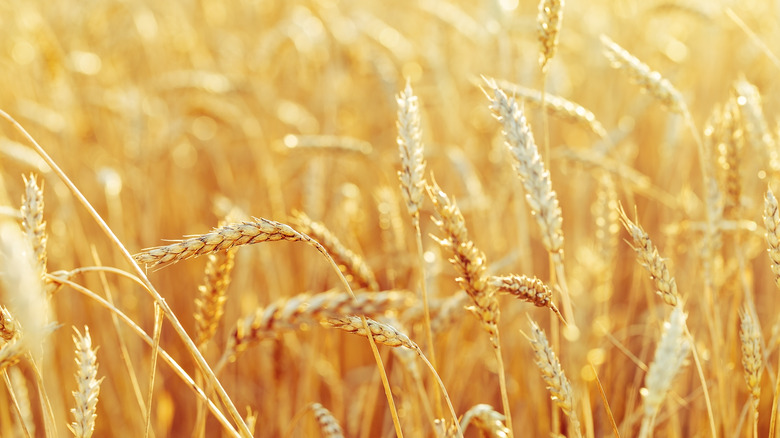Most Of The World's Wheat Comes From This Country
As a cornerstone of so many staples in the American diet, it's no surprise that wheat takes up roughly 37.2 million acres in this country, according to the U.S. Department of Agriculture (USDA). When you consider all the bread, beer, pizza, pasta, cereal, cookies, cakes, crackers, etc., that we eat on a regular basis, it's honestly surprising that wheat only ranks third among American crops in terms of total production. The USDA reports that farmlands devoted to corn and soybeans both outrank domestic wheat acreage.
Despite the rise of gluten-free as perhaps the culinary world's number one buzzword, the USDA still reports that Americans, on average, consume a disproportionately large amount of grain-based foods, exceeding dietary recommendations. Given the American diet's habit of regularly making news for all the wrong reasons, you might think this country outweighs the rest of the world in wheat production and consumption, but this is not the case.
The most populous country grows and consumes the most wheat
It probably won't come as much of a surprise to learn that the real leader in international wheat production is the most populous of all countries. According to the World Economic Forum, China grew an estimated 2.4 billion tonnes of wheat between 2000 and 2020, equal to 17% of the world's total supply. It was followed in the rankings by India, growing around 12.5% of the world's total wheat, while the United States tied Russia for third place, both producing 8.4%.
Bringing the conversation back around to China, it not only grows the most wheat of any country but also consumes more than any other nation, per the World Economic Forum, actually exceeding its production capacity. While the nation accounts for 17% of the world's wheat crop, it also accounts for 19% of global wheat consumption. Consequently, China uses most of its wheat domestically and imports additional supplies from other nations.
The largest exporter of wheat may surprise you
Although China produces more wheat than any other country, the Observatory of Economic Complexity (OEC) notes that its demand for wheat is so high it also imports the most of any nation. On the other end of the spectrum, wheat's largest exporter is Russia, accounting for roughly 19.5% of global exports. Russia Beyond reports that the nation ranks among the world's top 10 exporters of grain products in general, distributing massive quantities of barley, corn, and oats in addition to wheat.
As you might imagine, Russia's invasion of Ukraine (which happens to be the world's fifth-largest exporter of wheat, per the OEC) has upended the global grain trade, causing rising wheat prices. The BBC reports that the loss of Russian and Ukrainian wheat exports has had such a serious impact worldwide that it influenced the government of India to ban wheat exports, ensuring the country's entire crop goes to satisfy domestic demand.
Climate change threatens wheat production
War is not the only thing threatening wheat crops these days. The BBC coverage of India's ban on wheat exports also cites climate change, specifically the growing severity of droughts and flooding around the world, as major causes for concern, noting that in 2022-2023, global wheat stocks are expected to reach their lowest level in six years. Extreme weather phenomena took a serious toll on the U.S. wheat supply in 2022, as fields in Minnesota and North Dakota flooded while Kansas, the state which grows the most wheat, suffered severe drought.
Interestingly enough, NASA projects that the global wheat supply could actually increase in the near future, rising by as much as 17% between 2020 and 2030. However, this fact belies the severity of the climate crisis, as wheat yields are only expected to rise in high latitude regions experiencing a significantly warming climate, such as Europe. This could potentially make Russia an even stronger force in the global wheat trade. Meanwhile, regions nearer to the equator, such as South Asia, will see less wheat production, increasing their reliance on imports.



